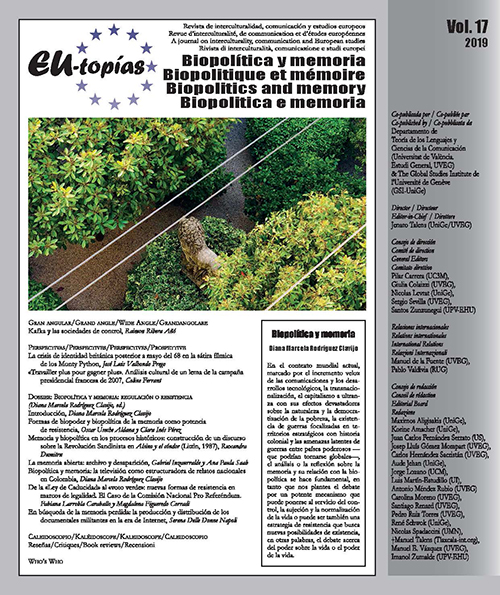Biopolitics and Memory. Television as Structuring System for National Narratives in Colombia
DOI:
https://doi.org/10.7203/eutopias.0.18324Keywords:
Empire, biopolitics, memory, narrativity, television Abstract
Abstract
The current television discourses are marked by the establishment of new ways of seeing: make see to «make feel» that there is no mediation between the reality created by the television medium and the reality as it is experienced by the subject. Throughout the 21st century, television series, defined by their producers as «fictions based on real events», have multiplied; among them, the narco-series made mainly in Colombia and Mexico. Escobar, el patrón del mal is one of such productions, which promises to provide a historical reconstruction of the Colombian war which struck the country during the eighties and nineties of the 20th century. The article originates from a research about the ways in which such television discourse is articulated, and about its possible effects on the Colombian collective memory. It moves from the acknowledgement of communication as a fundamental biopolitical mechanism of domination in the new world order.
 Downloads
Downloads
 References
References
BAL, Mieke (1998), Teoría de la narrativa. Introducción a la narratología, Madrid: Cátedra.
BUONANO, Milly (2000), El drama televisivo. Identidad y contenidos sociales. Barcelona: Anagrama.
CARMONA, Ramón (1995). Cómo se comenta un texto fílmico. Madrid: Cátedra.
CASETTI, Francesco y DI CHIO, Federico (1999), Análisis de la televisión. Instrumentos, métodos y prácticas de investigación. Barcelona: Paidós.
COLAIZZI, Giulia (2006), Género y representación. Madrid: Biblioteca Nueva.
COLAIZZI, Giulia (2007), La pasión del significante. Teoría de género y cultura visual. Madrid: Biblioteca Nueva.
ECO, Umberto (1986), TV: La transparencia perdida. En U. Eco (Ed.). La estrategia de la ilusión (págs. 200-223). Barcelona: Lumen.
ERLL, Astrid (2012), Memoria colectiva y culturas del recuerdo. Bogotá: Universidad de Los Andes.
FOUCAULT, Michel (1990), Tecnologías del yo y otros textos afines. Barcelona: Paidós.
FOUCAULT, Michel (1992), El orden del discurso. Buenos Aires: Tusquets editores.
GMH (2013), ¡Basta ya! Colombia: Memorias de guerra y dignidad. Bogotá: Imprenta Nacional.
GONZÁLEZ, Jesús (1999), El discurso televisivo: espectáculo de la postmodernidad. Madrid: Cátedra.
HARDT, Michael y NEGRI, Antonio (2002), Imperio. Bar- celona: Paidós
IMBERT, Gérard (2002), Televisión y cotidianidad, la función social de la televisión en el nuevo milenio. Madrid: Univer- sidad Carlos III de Madrid.
IMBERT, Gérard (2008), El transformismo televisivo. Postelevisión e imaginarios sociales. Madrid: Cátedra.
— (2010), La sociedad informe. Postmodernidad, ambivalencia y juego con los límites. Barcelona: Icaria Antrazyt.
LE DIBERDER, Alain y COSTE-CERDAN, Nathalie (1990), Romper Las Cadenas. Introducción a la Postelevisión. Bar- celona: GG Mass Media.
LEAL, Francisco (2006), En la encrucijada Colombia en el siglo XXI. Bogotá: Norma.
LOTMAN, Iuri y USPENSKIJ, Boris (1979), «El mecanismo semiótico de la cultura y la semiosfera» Semiótica de la cultura. Madrid: Cátedra.
Downloads
Published
How to Cite
-
Abstract334
-
PDF (Español)132
Issue
Section
License
![]()
The authors conserve the copyright. All content published in EU-topías. Journal of interculturality, Communication, and European Studies are subject to the license Creative Commons Attribution-NonCommercial-ShareAlike 4.0 license. The full text of the license can be found at <http://creativecommons.org/licenses/by-nc-sa/4.0>
They may be copied, used, disseminated, transmitted and publicly displayed, provided that:
- The authorship and original source of the publication is cited (journal, publisher and URL of the work).
- They are not used for commercial purposes.
- The existence and specifications of this license of use are mentioned.
It is the responsibility of the authors to obtain the necessary permissions for images that are subject to copyright.



